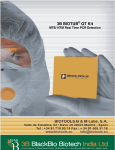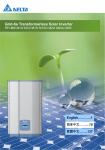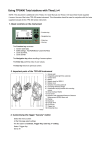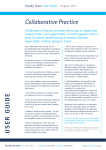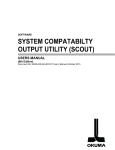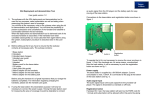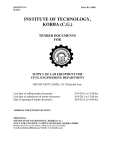Download Bus Drivers Emergency Procedures Guide
Transcript
Classroom C ass oo Emergency e ge cy Procedures ocedu es Guide BUS DRIVERS’ Emergency Procedures Guide Provided by the West Kentucky Educational Cooperative Please keep this pamphlet in your bus at all times times. © 07/2010; Marsh USA USA, Inc Inc. Violence / Crime: Violent Crimes or Sexual Battery (unwanted sexual contact or activity): • Stop bus in a safe location. • Call dispatch or 911, give location. • Do not move bus. • Evaluate the situation. • Verbally try to diffuse the situation – maintain control. • Maintain contact with dispatch. • Move victim to a safe location. • Render first aid to level of your training. Hostage Situation: • Remain calm. • If possible, possible call for help through dispatch or 911 911. • Cooperate with hostage taker. • Follow directions of law enforcement once they arrive. VIOLENCE / CRIME Demand to Remove Student Off of the Bus: Demand to Remove Student at an Unauthorized Stop: • Remain calm. • State that student is not allowed to leave the bus at that location for safety reasons, and without proper authorization. • Advise parent to contact school. • Indicate need to remain on schedule. • Inform parent of departure. • Continue on route. • Call dispatch to report incident. • Report incident to supervisor. If parent still insists on removing student: • Contact dispatch for approval to release student with proper identification (according to district policy). • Do not release student unless everything is in order. • Call 911, if warranted. • Record parent’s license plate and color of vehicle. • Note which direction they leave. DEMAND TO REMOVE STUDENT OFF OF THE BUS Disruptive Behavior – Student(s): • • • • • • • • • • Stop the bus. Park in a safe location off the road, perhaps at a parking lot or a driveway. Secure the bus. Take the ignition key with you if you leave your seat. Stand up and speak respectfully to the offender or offenders. Speak in a courteous co rteo s manner with ith a firm voice. oice Remind the offender of the expected behavior. Do not show anger, but do show that you mean business. If a change of seating is needed, direct the student to move to a seat near you. Never put a student off the bus except at school or at his or her designated school bus stop. • If you feel that the offense is serious enough that you cannot safely drive the bus,, calling g for a school administrator or the police p to come and remove the student may be appropriate. DISRUPTIVE BEHAVIOR – STUDENT(S) Medical Concerns: • • • Call Dispatch or 911 first if you suspect a medical emergency. You can always cancel the call if the situation is not as serious as it seemed! Understand the difference between an “incident” and an “emergency.” Examples of Incidents: – Vomiting – Minor cut (slow, minimal bleeding) – Abrasions/Contusions Examples of Emergencies: – Severe bleeding – Breathing problems – Anaphylactic reaction (shock) – Burns – Head, Head neck or back injury – Unconsciousness Do not perform first aid beyond your level of training. MEDICAL CONCERNS Drugs / Drug Paraphernalia: On the Way to School: • On Student(s) – Call dispatch, request School Resource Officer (SRO) and/or an administrator to meet the bus. • On the Bus – Call dispatch, request School Resource Officer (SRO) and/or an administrator to meet the bus (remember who is in that area on the bus). On the Way Home: • On Student(s) – Call dispatch to notify law enforcement. – Avoid confrontation with student. – If student discards itit, do not touch itit. • On the Bus – Call dispatch to notify law enforcement. – Do not touch it. DRUGS / DRUG PARAPHERNALIA Fire: • • • • • • Evacuate bus using all available exits and confirm that it is empty. Assess the situation and report to dispatch. If possible, turn ignition off and turn key to “On” so that the radio will be operational. If possible, drop radio microphone out of driver side window. If possible, take fire extinguisher, safety triangles and first aid kit. Assist any injured students. Mechanical Failure: • • • • • Find a safe location to pull off of the road. Contact dispatch dispatch. Evacuate the bus only if necessary (if evacuation is safer than staying in the bus). If possible, put out safety triangles. Monitor situation until help arrives. FIRE / MECHANICAL FAILURE If a Fight Occurs on the Bus: • Stop the Bus – Pull the bus off the road (safety first) • Evaluate the Situation – Students involved – Safety of other students • Radio the dispatcher • Use A Calm, Stern and Authoritative Voice – Give specific commands – Do not yell • Separate the Students – Position yourself between students involved while not placing yourself in danger – Use your body more than your hands • Remove Participants to a Neutral Location on Bus – Dismiss the audience • Get Medical Attention if Necessary • All Attempts Fail – Radio dispatcher to send proper authorities • Describe Incident in Writing to Transportation Director FIGHT ON BUS Hazardous Materials: Hazardous Materials are substances, or a combination of substances, which can pose a hazard to human health and/or environment when improperly treated, stored, transported, disposed of or otherwise managed. On the Road – Moving Bus: • Avoid area if possible. • If the bus has already entered the area where the chemicals were released – shut off ventilation, have students close windows, and quickly drive to a safer area. • Call dispatch or 911; await instructions. On the Road – Bus Stopped in Traffic: • Shut off ventilation, ventilation and have students close windows. windows • If possible, move away from the area where the chemicals were released. • If the bus can’t be moved, call for help via dispatch or 911 – emergency responders can advise you on whether or not you should evacuate the bus. On the Bus: • Call dispatch or 911. • Leave hazardous material where it is. • Evacuate the bus. DO NOT RE-ENTER BUS! • Decontaminate following recommendations of emergency responders. • Emergency responders should evaluate potential medical concerns. If similar medical symptoms begin in 2 or more students (dizziness/lightheadedness, nausea/vomiting) there may be chemical contamination. HAZARDOUS MATERIAL Disruptive Behavior – Parents(s): Verbally Abusive: • Remain calm. • Attempt to calm parent. • Suggest calling parent after run is completed. • Direct parent to call supervisor supervisor. • Indicate need to remain on schedule. • Inform parent of departure. If parent remains confrontational, have dispatch call 911. • Continue on route. • Notify dispatch of incident. • Report incident to supervisor supervisor. Demanding to Board Bus: • Remain calm. • Attempt to calm parent. • Offer to call parent after run is completed. • State that school board policy does not allow for parents to board bus – boarding the bus is trespassing and law enforcement will be called. • Direct parent to call supervisor. • Notify dispatch of the situation. • If the parent boards the bus, have dispatch call 911. DISRUPTIVE BEHAVIOR – PARENT(S) Pre-Trip and Walk-Around: • • • Every pre-trip and walk-around inspection should include keeping your eyes open for anything that has been tampered with or is out of place. If you believe there is anything unusual about your bus, you should report it immediately to the dispatcher / transportation director / head mechanic / designated person. You should also request police assistance. Bomb Threat Received: • • • • • Radio or telephone situation and location only if it can be done safely. Attempt to learn the following: – When is the bomb going to explode? – Where is the bomb located? – What Wh d does the h b bomb b llook k lik like? ? – What will detonate the bomb? Negotiate to stop bus and evacuate students. Negotiate to notify police/bomb squad/EMS. Negotiate. Negotiate. Negotiate. Suspicious Device Found: • • • • • • Do not touch the suspicious device. Turn all radios and cell phones off (including student cell phones). Stop bus in a safe location (sparsely populated, open area, away from hazardous areas such as a gas station). Evacuate students to a safe location at least 1500 feet away. Keep students contained in one area. Notify 911 911. Do not use radios or cell phones within 300 feet of device device. BOMB THREAT / SUSPICIOUS DEVICE If a Weapon is Suspected: • Be vigilant but do nothing to create a more dangerous situation. • Radio or telephone situation only if it can be done safely and discreetly (consider using a code to prevent alarming students.) Ask for police assistance. • Limit the number of people who have this information. • Mi Mimic i b bus ttrouble bl and d stop t en route t iin as safe f an area as possible. ibl (Y (You may need to evacuate students). • Try to remain in contact with dispatch. • Follow directions of law enforcement when they arrive. If a Weapon is Visible: • Be vigilant but do nothing to create a more dangerous situation. • Radio situation only if it can be done in code. This code should alert dispatch to notify police for assistance and to notify the superintendent. Limit the number of people who have this information. • Follow instructions of person with the gun or other weapon. • Attempt to keep bus atmosphere calm. • Attempt to negotiate the release of students. If a Weapon is Actively Used: • Stop bus immediately, as safely as practical. • Evacuate bus to a safe location. location • Notify 911. • Notify dispatch and remain in contact if practical, give location. WEAPON Tornado Alerts: Tornado Watch: Conditions are more favorable than usual for a tornado. Tornado Warning: A tornado is about to happen or has been reported. A warning is more serious and means you should take action to protect life and property. T Tornado d in i Immediate I di t Area: A Go to pre-identified shelter if possible. If you can’t, do the following: • Do not attempt to ‘out run’ the tornado. • Stop and evacuate the passengers. • Do not remain on the school bus. • If the bus is radio equipped, advise dispatch of your bus number and location. • Seek safety y in a below g ground level area,, such as a low ditch,, ravine,, or depression in a location that is: – away from the bus – on the side of the road without power lines, utility poles, trees etc. • Do not use above ground locations for shelter (e.g., road or bridge overpasses). • Instruct students to lie flat face first and to protect their heads by using a jacket, other clothing, or their hands and arms. • Advise students not to sneak a peak at the tornado. tornado If the bus is exposed to hail and/or high winds: • Keep the students on the bus. • Have students take shelter in the bus by crouching down between the seats and protecting their heads with their arms. • Obtain clearance from dispatch before proceeding to your destination. After the Emergency • Account for all students, check for injuries, and provide first aid if needed. • Obtain medical attention if needed. • Before leaving a shelter or the immediate area, if out in the open, monitor the local sky for a few minutes in the direction the tornado came from to ensure a second tornado does not follow a similar path. • Be alert for continued storm activity, downed power lines, ruptured gas lines, or structural damage to trees trees, buildings buildings, roads and bridges bridges. TORNADO Severe Weather: • It is advisable that while on your route, you should locate safe places to stop your bus in case of severe weather. • Be aware of any advisories regarding fog. • Decrease speed in severe weather situations. • Always activate roof-mounted white flashing strobe light when visibility is limited. • Notify dispatch of any dangerous limited visibility areas, unsafe situations, and any route delays. • In lightning, hail, wind less than 35 miles per hour, or heavy rain, drive with care as long as visibility is sufficient for safe operation. • The danger of hydroplaning is greatest when rain first starts – oil on the roadway gets slicker in the first minutes of rainfall. • Be aware of debris in the roadway and never drive across downed power lines. • If severe weather occurs while en route with pupils, park the bus in an area away from potential falling objects and remain there until the storm is over. Use flashing hazard and amber lights to maximize visibility of the bus. • In extreme weather such as heavy lightning, large hail, or freezing rain, attempt to drop off students at the safest possible location ((this mayy mean keeping ga child on the bus). Notify dispatch of any changes if children are not dropped off at their usual stops. Floods: • Be aware of any flood advisories and the flood prone areas on your route. • Inform dispatch p in the event a road is blocked and before an alternate route is used. • Do not attempt to drive through standing water with a school bus. • Have an alternate route if this should occur. • Use caution if part of the roadway is covered by water – the road below could be damaged or destroyed by floodwaters. • If bus stop area is flooded, contact dispatch for advice. Possible dangers to students could be floodwaters contaminated by sewage, sewage downed power lines with a risk of electrocution, swift current or dangerous wildlife such as snakes. SEVERE WEATHER Bus Accident Procedures: • In the event of an accident involving a school bus while transporting students, the driver's first responsibility is the welfare of the students. • Stop the vehicle immediately, no matter how trivial or unimportant the accident may seem. Do not move the vehicle unless authorized to do so, or unless its location may y result in further danger. g • Turn off the ignition, set emergency brakes and turn on four-way flashers. • Check and care for injuries – Calm students. • Evacuate the bus if there is more danger in the bus than outside. Move them to a safe distance from the bus. Place older students in charge of the group. • If necessary to remove injured students, do so with extreme care as not to injure them any further. Only under extreme conditions should an injured student be moved d other th th than b by properly l ttrained i d emergency responders. d • Survey the scene and evaluate situation. • Prevent or extinguish fires. • Protect students from other traffic hazards by setting out flags or reflectors. • Notify dispatch – give location, number of injuries, type of incident, condition of bus, and emergency personnel needed (police, ambulance, fire department, etc.) • Have available: manifest, manifest CDL, CDL physical card and proof of insurance. insurance • Collect information pertinent to the accident such as names, license numbers, registration numbers, location, time, road and weather conditions. • Supervise students. • Assist emergency personnel. • Do not release students to anyone without proper authorization (e.g. law enforcement, superintendent or his/her designee). • In making any statements, be accurate and factual. – Make no admission of fault. – Make no accusations. – Do not discuss accident with anyone other than a law enforcement officer, school bus company manager or school superintendent or his/her designee. • Driver Di mustt b be available il bl ffor postt accident id t d drug ttesting ti if required. i d BUS ACCIDENT PROCEDURES Bus Evacuation: • • • • • • • The safety of students is of utmost importance. Give this first consideration. Driver should stay on the bus to guarantee smooth evacuation. Conduct evacuations with “deliberate speed.” 1½ to 2 seconds per student. To insure a safe exit, students should leave personal belongings on the bus. Students selected and trained in advance should be assigned to serve as helpers to aid students as they evacuate the bus via the rear emergency exit. Direct students to remain at least 100 feet from the bus until further notice. Account for all students after completing the following procedures: Evacuating through the front door 1. Set park brake and turn off engine. 2. Put transmission in reverse (manual transmission) or park (automatic transmission). transmission) 3. Turn on four-way hazard lamps (if operable). 4. Driver should stand and face students. 5. Test front service door to see if it is working before making announcements. 6. Get the students’ attention - speak clearly and concisely. 7. Evaluate the situation (injuries, safe waiting area to move the students to). 8. Announce to the students to exit through the front 9. Give first aid kit, extinguisher and reflective triangles to responsible students. 10. Check to make sure all students are out. 11. Assist the injured to the best of your ability. 12. Notify proper authorities as soon as possible. Evacuating through the rear and or side door 1. Steps 1 through 3 in the front door evacuations need to be followed. 2. Assign two "helpers" to assist students. 3 Instruct helpers to "sit" 3. sit on the floor and "scoot" scoot out the door onto the ground. ground 4. One helper is positioned so that the emergency door will not swing against the students. The other helper is positioned on the other side of door area. 5. The helpers need to hold a hand open, palm upward and extended for the student to place his/her hand on it. The other hand will support the upper part of the arm of the exiting student. 6. Evacuate the bus, starting at back row and continue to the front. 7. Students should "squat" at the rear door to prevent hitting their head. 8. Have the student "drop" not “jump” out of the bus. 9. Have them walk to the designated safe waiting area. 10. Give first aid kit, fire extinguisher, and emergency triangles to students. 11. Have the helpers assist you out of the rear of the bus. 12. Assist the injured to the best of your ability. 13. Notify proper authorities as soon as possible. Emergency Evacuation Procedures - Special Needs Students 1. Notify dispatch of your location and the exact nature of the problem. 2. Helpers should open rear door and spread a blanket on the floor of the bus. 3. Driver must help in releasing the students from their seat belts. Use seat belt cutters to facilitate a quicker removal of students from a wheelchair or from a Child Safety Restraint System (CSRS). 4. Students in wheelchairs should be placed on a blanket one at a time and moved to the emergency door. 5. Driver should pass each student, one at a time, to the helpers standing outside the bus. Repeat until all wheelchair students are off the bus. 6. Driver and helpers can then assist any ambulatory students who have not previously been able to evacuate the bus. 7. Retrieve first-aid kit and the body fluid cleanup kit if safe to do so. BUS EVACUATION
















